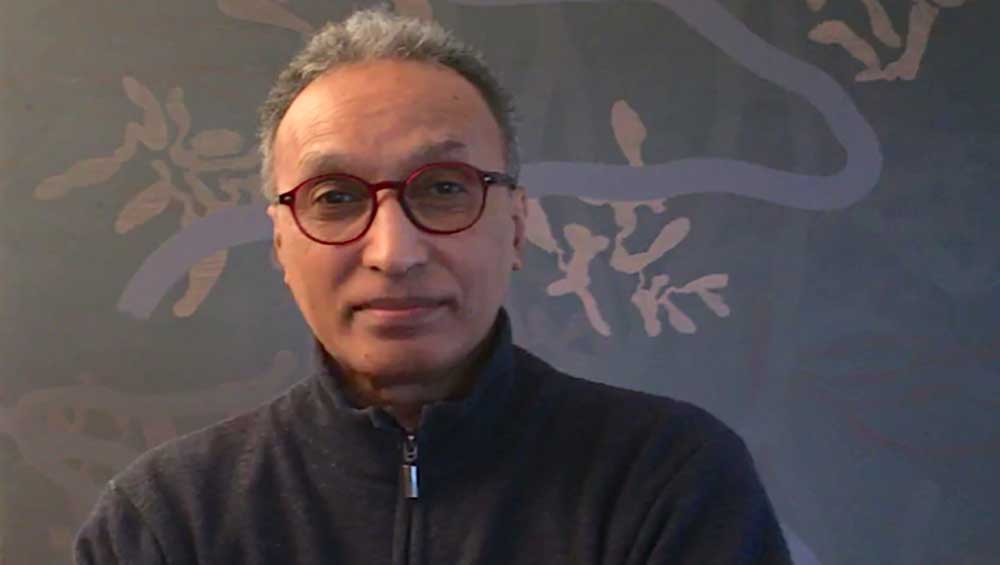
Portrait of Gavin Jantjes Photo: Angela Musil. Courtesy the artist.
by JOE LLOYD
“The only history in the painting is the marks that tell you where the painting has gone,” says Gavin Jantjes. I am with the South African-born, Oxfordshire-based artist in a meeting room at the Whitechapel Gallery. He is on site to assist with the installation of To Be Free!, his retrospective at the East End institution. Later on, as art handlers unwrap prints and prepare to lift canvases up on to the walls, he shows me the paintings he has been working on for the past decade.
They are non-figurative, featuring numinous forms and colours, applied in a paint so thin that you can see every swoop and stroke. Jantjes compares them to the ceilings of Tiepolo, those brave overhanging firmaments. This recent work seeks to create emotional effect through paint alone. He recalls going to the Centre Pompidou and being so transfixed by Matisse’s cut-out The Bees (1948) that he had to sit down and gaze at it, to the guard’s perturbance. Jantjes aims for a similar effect.
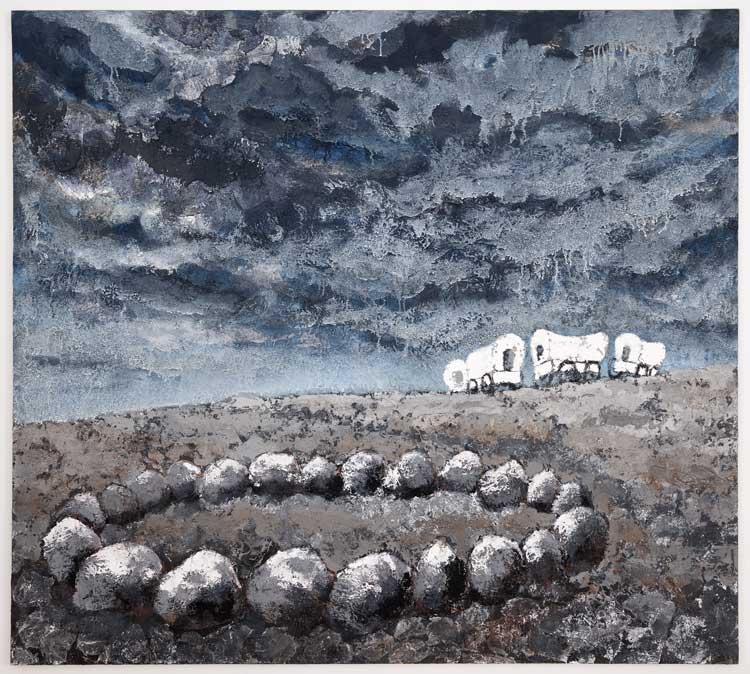
Gavin Jantjes. Vaal, 1987. Acrylic on canvas, 189 × 200 cm. Courtesy the artist. Image courtesy the artist. Photo: Ann Purkis. © Gavin Jantjes, licensed by DACS.
But it is difficult to talk about Jantjes’ work without looking at history. To Be Free! is timed to mark the 30th anniversary of South Africa’s first free elections in 1994. Downstairs at Whitechapel, one encounters Jantjes’ paintings of the 1980s and 90s, which are often suggestive of African history. Vaal (1987) places settler wagons opposite a stone circle, the coloniser meeting the indigenous. Untitled No 2 (1986) shows coffin-shaped ships crossing the rolling Atlantic. And the mixed media canvas Half the Sky (1988) turns the names of female anti-apartheid activists into a celestial constellation.
Jantjes was born in Cape Town’s diverse District Six in 1948. His first experience of art came at the Children’s Art Centre at St Philip’s Primary School, a project founded to keep the children of working parents occupied after school. He became the only black student studying at the University of Cape Town’s Michaelis School of Fine Art. He then wanted to get out of his apartheid-governed country. “I made applications to England, Canada, Japan, Latin America, Australia. I wrote to about 50 embassies asking if there was any way I could get a scholarship. And I got two replies.” One granted him a DAAD scholarship for the Hochschule für Bildende Künste in Hamburg.
“When I got there,” Jantjes recounts, “I decided to do something that I could never do in South Africa, which was to make photographic screen prints.” His 1974-75 print portfolio A South African Colouring Book, which looked at the ironies of white South Africa’s use of the term “colour”, proved a breakthrough. It was shown at the ICA in 1976, as South African police murderously suppressed protesting high school students in Soweto. Jantjes moved to Wiltshire in the 1980s, where he switched to painting. His output of this period interrogated the connections between African and European art.
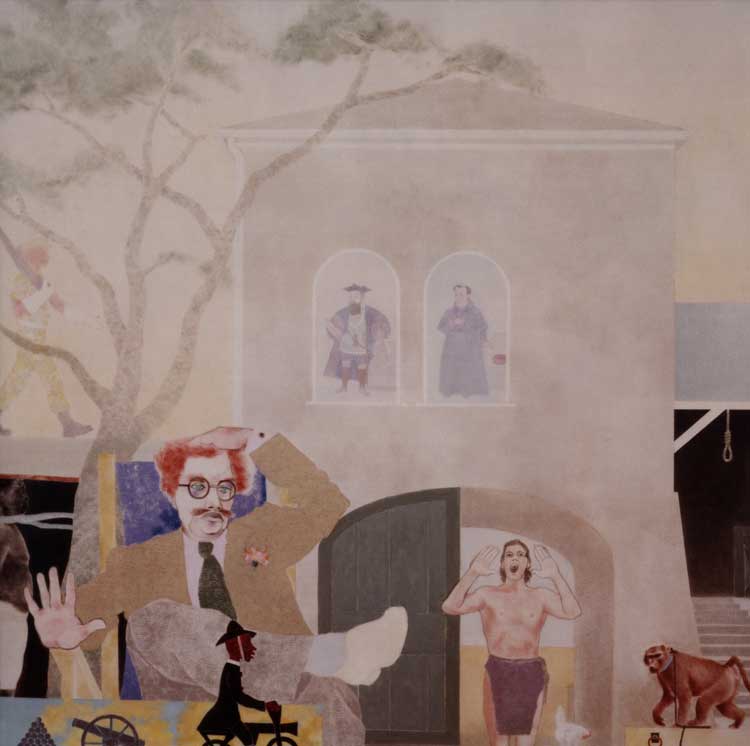
Gavin Jantjes. Before Maputo, 1982. Oil on canvas, 150 × 150 cm. Courtesy of TOTAH, New York. Image courtesy the artist © Gavin Jantjes, licensed by DACS.
Jantjes began to devote more and more time to reforming art in Britain. “I realised that there were a lot of different avenues in the visual arts I could move into,” he says. He worked to diversify the Arts Council’s then very-white portfolio. He helped to found the Institute of International Visual Arts (Iniva), which supports artists and curators of colour. In 1986, he co-curated the groundbreaking From Two Worlds at Whitechapel, which collected artists with diverse cultural backgrounds living and working in Britain. Then, in 1998, he was appointed artistic director of Henie Onstad Kunstsenter near Oslo and hung up his brushes to curate, write and lecture. Both there and later at the Norwegian National Museum, he continued to promote global voices in art.
In 2014, after 16 years in Norway, Jantjes resolved to return to practice. A new phase of his work began, which sought to speak in a visual language alone. To Be Free! captures these very different facets of Jantjes’ many-sided career.
Studio International spoke with Jantjes at Whitechapel about his artistic, administrative and curatorial practices.
Joe Lloyd: And what led you to pursue art as a career?
Gavin Jantjes: I was asked that question by a 15-year-old Dutch boy in Amsterdam. And I thought, rather than giving him a flippant answer, I would answer seriously. I hadn’t seriously thought about why, but what I came up with, I think, was very pertinent. It became the space in my life where nobody told me what to do. I could do what I wanted. I felt completely free in that space.
I went to the Children’s Art Centre from the age of three, then at the age of 16 I started as a part-time teacher. It was very strange, because I was teaching life drawing to people in their 30s, 40s and 50s. So, there was this young kid teaching these adults how to draw from life and do still life.
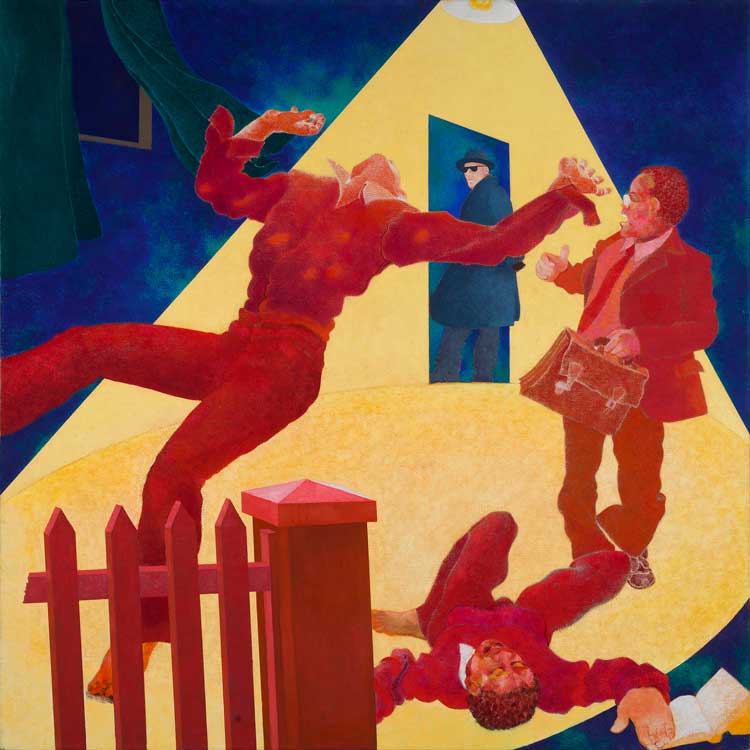
Gavin Jantjes. Amaxesha Wesikolo ne Sintsuku (School Days and Nights), 1978. Oil on canvas, 150 × 150 cm. Private Collection, Johannesburg. Image courtesy the artist © Gavin Jantjes, licensed by DACS.
JL: What work did you do while at Michaelis?
GJ: Two or three days a week we had full days of life and still life drawing. It had a very figurative orientation, very much like a British art school, but without the staffing requirements. I did a course initially in graphic design, then I moved to what was called free graphic art. I was making black-and-white etchings, a lot of black and white. It was all I could afford. I finished three years as a graphic designer, and then as a free graphic artist I primarily made etchings, linocuts and drawings.
The first exhibition I ever did at Cape Town was at the Artists Gallery. That was a gallery run by artists who were unhappy with the only other outlet in Cape Town, the National Gallery, which was a purely state-run, white institution. Black people couldn’t get through the doors and they finally arranged that you could enter for a few hours on a Sunday. A group of artists needed their own facility, so they started a gallery. It was limited to a certain number of artists. You had to apply and have three artists to support your application. Teachers recommended me and I was accepted.
I think I was the second black artist to be in that group. The first was Peter Clarke, who became a personal friend – he was a writer, a poet and a visual artist. Langston Hughes was a friend of his. Peter was always encouraging me to be an artist. And that is how I started basically. That’s what gave me the incentive.
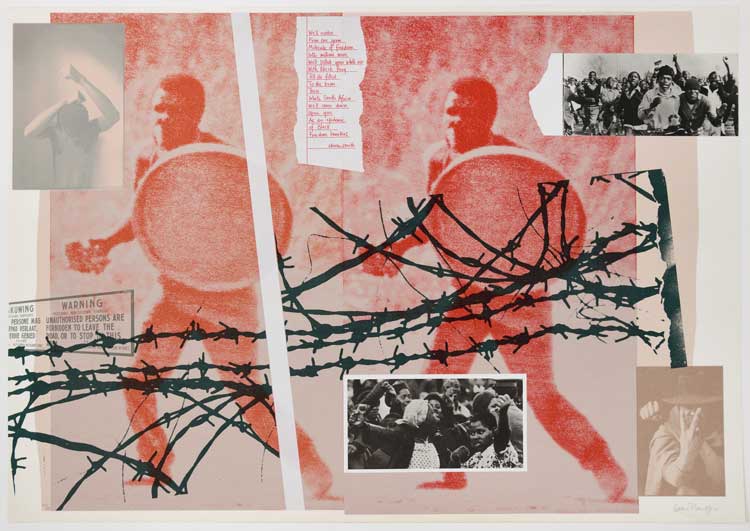
Gavin Jantjes. Freedom Hunters, 1977. Screenprint on paper, 100 × 70 cm. Courtesy the artist. Image courtesy the artist. Photo: Ann Purkis. © Gavin Jantjes, licensed by DACS.
JL: How was your experience of German art education?
GJ: When I got there, I decided to do something that I could never do in South Africa, which was to make photographic screenprints. That was really of the time – it was pop art. Everyone was making photographs and collages. I was really thrilled by that.
When I arrived, the director of the academy was the secretary-general for Documenta, so he had a direct contact to all these artists. We had Richard Hamilton, Eduardo Paolozzi, Joe Tilson, David Hockney, Richard Smith … The student body had the right to choose one guest lecturer per term. And this was the time when Joseph Beuys had been kicked out of Düsseldorf. So, we invited him to come and teach in Hamburg. He came for almost a year. He would come for a week every three weeks and work with us. And he was the best teacher I ever had. He was amazing as an individual, as a visionary. He just had a knack of working with young people.
JL: After Germany, you came to England. Why?
GJ: Joe Tilson, who died last year, was very encouraging. He said: “Why don’t you come and live in England?” He had just acquired a new house and there was a small cottage next to it. He said: “You can live in the cottage and we’ll make a studio for you in the house.” So that’s what I did. When he invited me in 1982, all the pieces of the puzzle were fitting together.
By then, I had already had an exhibition of my screenprints at the ICA in 1976. I showed the Colouring Book in Hamburg, and Joe Tilson said: “Come to London and just show it to people.” I walked around, portfolio in hand, knocking on doors. I went to the V&A and they bought the very first copy, just like that. At Marlborough Graphics, I met [gallerist] Alan Cristea, who introduced me to Edward Totah, who became the first gallerist to represent me.
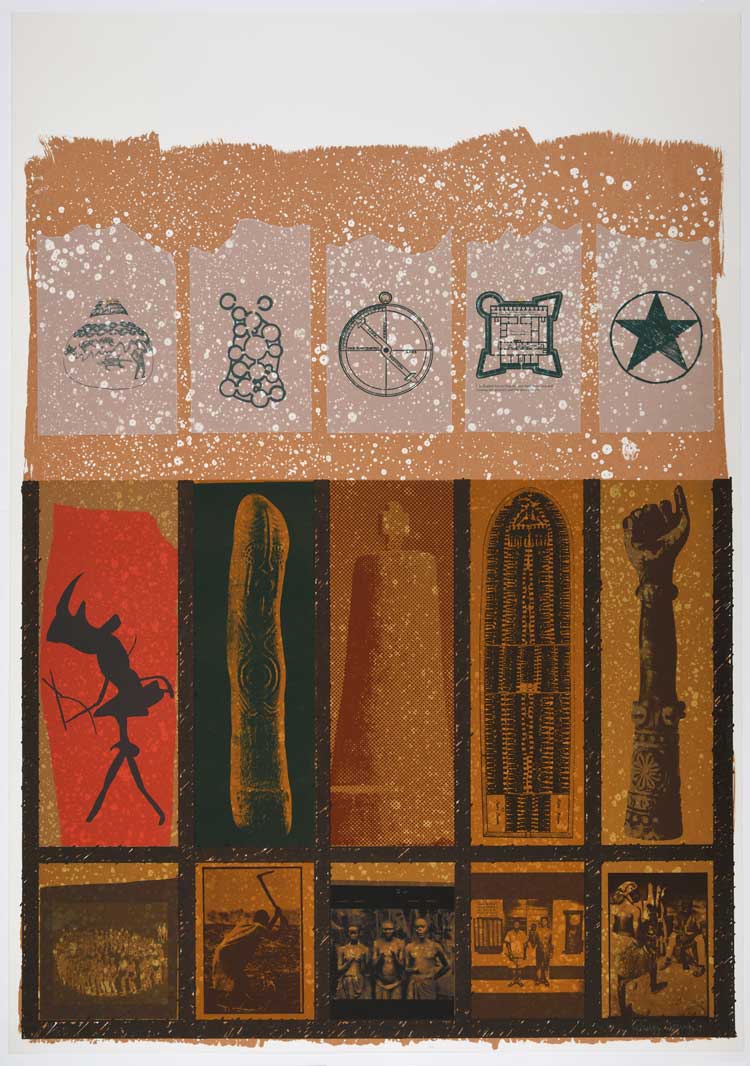
Gavin Jantjes. Notes from History, 1977. Screenprint with collage, 100 × 70 cm. Courtesy the artist. Image courtesy the artist. Photo: Ann Purkis. © Gavin Jantjes, licensed by DACS.
I went to the ICA, where Barry Barker was exhibitions officer. He took one look at the Colouring Book and said: “Yes, we’ll show this next month.” I left the prints with him, and came back a couple of weeks later. We framed them. Then in June, the Soweto Uprising happened. The ICA had an exhibition that was absolutely topical. The Colouring Book became a big discussion point in the artistic address of the apartheid situation. That was very lucky and very opportune. One of my colleagues in Hamburg was Rebecca Horn. I told her I had an exhibition at the ICA and her jaw dropped. At that time, the ICA was the most experimental contemporary art institution in Europe.
JL: What was the situation for artists of colour in London when you moved there?
GJ: When I came, there was no other black artist in London that had a gallery. Around then, Anish Kapoor and Shirazeh Houshiary became part of Lisson, and then Dhruva Mistry joined a gallery. We were the only four artists of colour showing in mainstream West End galleries at the time. Yinka [Shonibare] joined Stephen Friedman after. We were the exception to the rule. Even established artists like Rasheed [Araeen] and Frank Bowling could not get a foot in the door; I don’t know how Frank survived.
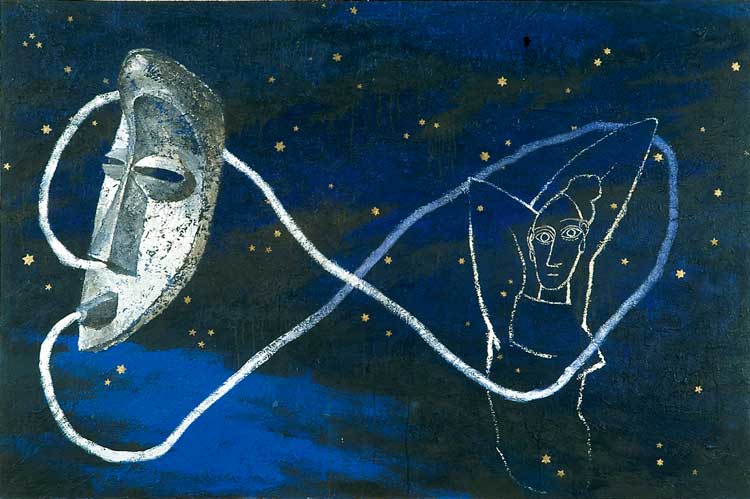
Gavin Jantjes. Untitled, 1989. Acrylic on canvas, 200 × 300 cm. Arts Council Collection, Southbank Centre, London. Image courtesy the artist. © Gavin Jantjes,
licensed by DACS.
JL: In the 1980s, you worked with the Arts Council. How did that come about?
GJ: Rasheed, myself and a number of others started taking platforms in conferences, challenging the establishment. Then one day I was on a US lecture tour and my wife called me and said: “You have a letter from No 10 [Downing Street].” I thought it would be some sort of publicity. But we opened it up and it said that Margaret Thatcher wanted me to serve on the Arts Council. And I was like: “How the fuck did Margaret Thatcher get my name?”
Rasheed should have been on the council 20 years before I arrived. Everybody hated Rasheed’s guts because he spoke truth to power, telling them exactly how racist they were. Nobody wanted to work with him. But he was right. He forced the institution to take a look at themselves. I had arrived in England, was from nowhere and had no kind of battle or boxing matches with anyone. But I had a critical opinion and so they invited me to come and serve. The chairman then was William Rees-Mogg. He was a staunch Conservative, but I got on marvellously with him. He said: “Tell us what you need and the kind of budget you want.” And I said: “I don’t need any budget. The Arts Council has to be seen to be taking the action.” I started a committee to look at it, the power to prepare a white paper so that it has to be discussed, a policy decision has to be made.
When we decided to look at how the council had distributed funds, we realised that the literature department had, in something like 15 years, never given a substantial grant to a black writer. We decided that, for one year, we would take the entire literature budget and give it to black writing. Fiona Pitt-Kethley, a writer of salacious novels, laid a charge of discrimination. I got a call from William: “We’re in deep trouble.” There was a writ to appear in the high court. We went for three days, and the judges decided that the council had a right of duty to address a social need. So, Fiona gave us the best excuse.
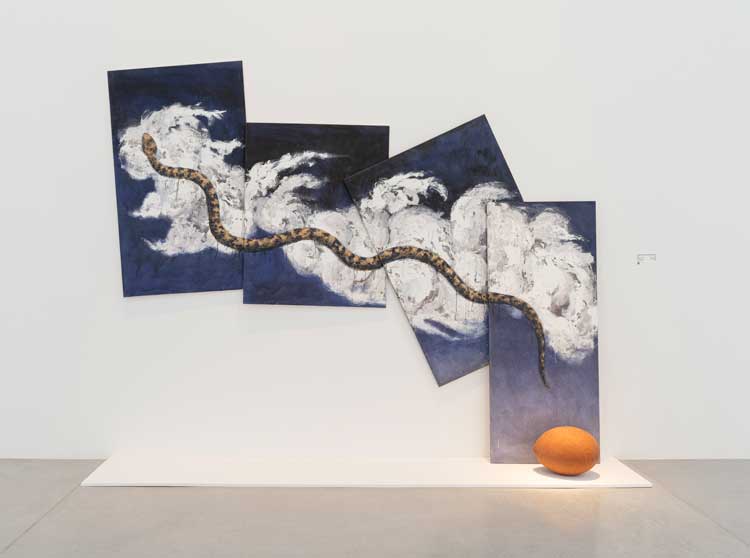
Gavin Jantjes. Untitled, 1989. Acrylic on four canvases and ceramic egg, 300 × 304 × 56 cm. Courtesy the artist. Image courtesy the artist. Photo: Ann Purkis. © Gavin Jantjes, licensed by DACS.
JL: After moving to Wiltshire, you moved away from printmaking and towards painting. Why?
GJ: When I moved to the UK, I no longer had a print workshop and we had started a family. My wife was working, and I couldn’t take my kids with me into a print workshop. So, I started working at home, making drawings. I had never trained as a painter, so I had to teach myself. I collage, I find things and I put them together. You put incongruous things together, and you’ve suddenly got a discourse and a subject emerging. And you could to a large degree control that, and if you used some text you could definitely control it. I thought, OK, I’ll make some collages. I made lots of drawings, then I would collage these drawings together and begin to build images for paintings.
JL: Did you feel boxed in as a “political artist”, rather than a painter and a printmaker?
GJ: I made work where the subject matter was so important that the vehicle that brought the subject matter to you was almost ignored. Nobody would look at my prints and say: “Holy shit, how is he doing this.” And they would do this with Rauschenberg, they would do this with other printmakers who were using similar techniques.
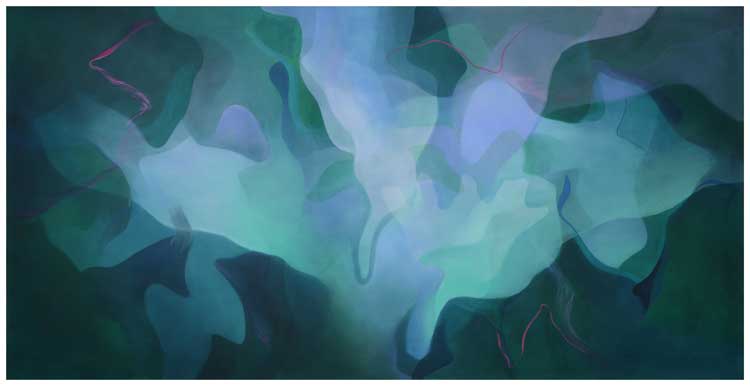
Gavin Jantjes. Untitled BB from The Witney Series, 2022. Acrylic on canvas, 145 × 275 cm. Courtesy the artist. Image courtesy the artist. © Gavin Jantjes, licensed by DACS.
When it came to me that the first thing I was always asked about was my political affiliation, rather than my cultural affiliation. I stopped making these overtly political works, and started focusing more on African culture. But then it became an issue of identity: “You’re an African living in Europe. You’re dealing with a historical past, like this and this and this …” And the more I dealt with this, the more I got frustrated.
I started making paintings without any titles. I made paintings where the imagery was more poetic than overtly clear. One image I used, which has become a leitmotif, was the image of a fang mask with a figure from Picasso’s Demoiselles, bringing those two together in a completely neutral space, the night sky.
JL: Did this contribute to your pause from art?
GJ: Yes. And Edward Totah, my gallerist, died very suddenly. He was about my age. And he just fell one day in the kitchen. Boom, he was gone. There wasn’t anyone else who I wanted to work with, or who wanted to work with me. At the time, with my position at the Arts Council and my lectureships, and by working to create Iniva, I realised that there were a lot of different avenues in the visual arts I could move into. If I didn’t have a catalyst, maybe I should do something else for a while.
I had been invited to be a guest professor at Bergen Art Academy, so I went there for a few months. I was invited to have an advisory meeting with Henie Onstad Kunstsenter. I talked to them and was willing to give them advice as a consultant. They wanted me to come and run the institution. I thought, now was an opportunity to do everything I’d been trying to get Tate to do, and the Hayward to do, and the Whitechapel to do, where I had to deal with all these hurdles. This is a way to highlight the issue of diversity. I now had open access to do it myself. I had an institution. I dropped everything, gave up my lectureship, moved to Norway and ran Henie Onstad for six years. And then Sune Nordgren, after he had finished at the Baltic, asked me to come and join the new Norwegian National Museum, where I stayed for 10 years.
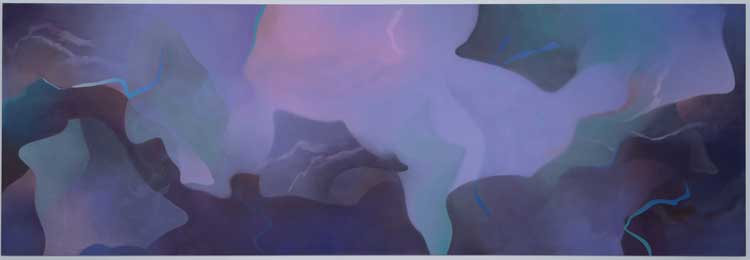
Gavin Jantjes. Untitled from The Sharjah Series, 2022. Acrylic on canvas, 200 × 600 cm. Courtesy the artist. Image courtesy the artist. © Gavin Jantjes, licensed by DACS.
JL: As a curator, you championed many artists from diverse backgrounds while pushing the contemporary art world to a more global outlook. Why did you then decide to return to painting?
GJ: I started getting very tired of postmodern discourses. I thought I was going round in circles. And I realised that I was going to galleries and reading texts. We go to libraries to read text. We go to galleries to look. They’re called visual art institutions. They should not be about the discourse. The vision is gone.
So, I made a large-scale exhibition of drawing, and a large-scale exhibition of painting, An Appetite for Painting, over a three-year period with two major conferences. By the time I was halfway into that, I realised I didn’t want to curate any more. I wanted to go into the world and make art where nobody was talking about my cultural background, my personal history as an anti-apartheid activist, the work I did for the UN. I wanted people to just look at the stuff and say: “Is this good painting or is it not.”
JL: Hence your choice of non-figurative works, with no clear political or historical content?
GJ: I decided to take away. When you have a problem, the best way to deal with it is to reduce everything. Matisse did it with drawing. Giacometti did it with sculpture. I thought I would take away the subject. And I’d take away the flawed American belief that the only way you could make abstract art was to literally bring the material to the canvas with a trowel. I decided to paint with the least amount of paint I could find. The least amount of pigment in the paint I could find. And make a work with no subject matter.
The only history in the painting is the marks that tell you where the painting has gone. I’m painting with such thin paint, such translucent colour, that every mark I’ve laid down reveals the mark underneath. There’s always a trace. That’s the only history you have in the work. You’re standing there and you’re saying: “How is this? What is this?” It’s this thing you don’t know, you’ve never really understood.
JL: How did you teach yourself to paint in such a different mould?
GJ: I’d never done any of this in my life before. What was this about? I said I’d give myself two years to find out. I converted my dining room into my first studio, and I started out with three canvases, which became 14 canvases, the Exogenic Series. And they were just me having fun with paint basically. I made these paintings trying to think, what is it I am doing, what is it I am trying to address here?
And a few things became clear. First, my paintings were about space. Not necessarily a physical space but an emotional space. What I wanted to share with the viewer was to get them to accept what was in front of them. Don’t look at it on a computer. It’s not the same experience. If I showed you a photograph of Victoria Falls and I took you there, you would realise the difference between the two. The one you’d hear the thunder, your body shakes, your skin is wet. It’s an energy that you just cannot even imagine. It’s just thunderously magnificent. And it’s the same with painting. If I showed you a Helen Frankenthaler in a print, printed in a book, it would look quite beautiful. But I guarantee if I showed this to you in real life you would be knocked out.
I always tried to teach my students to ask themselves when visiting a gallery, where they stop and why. If you answer that question, you may understand something. Your eyes tell your brain to instruct your brain to stop moving. It’s a visual thing that generates some kind of thing in your brain that tells your body to respond in some way. That has happened to us as human beings from the moment we were born. After touch, the second most sensory thing is sight. And from sight, we deduce, we create language and meaning, etcetera. These are so important to us. I want the person who stands in front of my new paintings to enter into this space.
JL: The exhibition is titled To Be Free! And your recent paintings represent a freedom from the burden of your past work and associations.
GJ: I’m being free from expectation that, because of who I am and where I come from, I have to produce a particular kind of visual imagery. I want to be free to actually just offer you something that says: “This is me; this is what I do.” How you react is what you do. I’m not instructing you to do something. I’m just offering you something.” You can go ahead and enjoy this, or you can move on to the next thing. But if you are here and something happens, there is something very, very, important going on.
I’ve had that experience on a number of occasions. The very first time it ever happened to me was when I went to the Centre Pompidou and I saw a Matisse paper cut-out, The Bees. The scale of it knocked me off my feet. I sat on the floor of the gallery and a guard came up to me and said: “Are you OK?” That left me shaken. The other time was in the National Gallery in Washington DC, where they had assembled all the Frankenthalers in one room. And there in front of me was Mountains and Sea (1952). And I just thought: “What the fuck is this? Wow!” It’s nothing, but it’s so much. It touched me so deeply, it moved me so strongly, that I just thought: “This is how art is supposed to be. This is how people who had no visual experience when they saw their first Michelangelo or Donatello reacted.” It meant something very personal and moving.
And what it’s saying to you is that you are an individual who has emotions. Those emotions are created by you. And if you don’t allow others to control you, then you are being yourself. You are actually saying: “I’m a free human being with the capacity to relate and have a conversation and enjoy this thing in my visual space.” And if I can get people to do that with the new work that I’ve created I will be extremely happy.
JL: What is the process by which your paintings come into existence?
GJ: I think about a goal that I set myself, what is happening? Why tell me what to do rather than me going to try to make the work. I start with a blank canvas, and I put a colour down, and there’s where I start. I don’t have to draw. I don’t have studies. I just start. There is a conversation that is set up between this object on my studio wall and me. And sometimes I want to have a conversation and I work. And sometimes I want to put it away, and then I come back and open the conversation again. And, finally, there’s nothing more to be said between myself and the work. Then it’s done. Then I know.
Click on the pictures below to enlarge